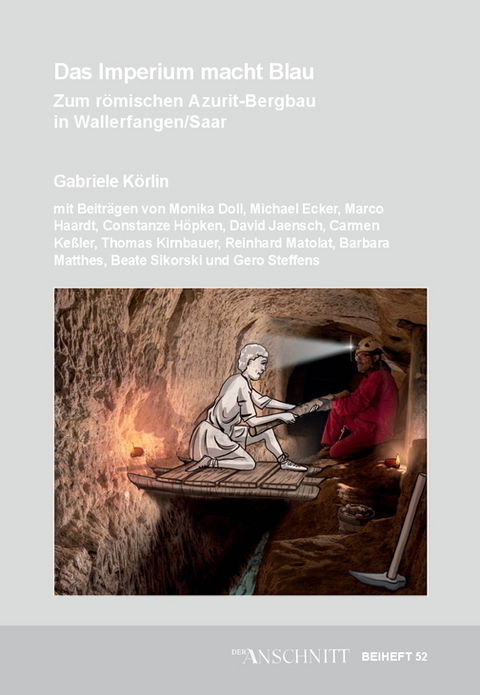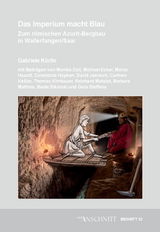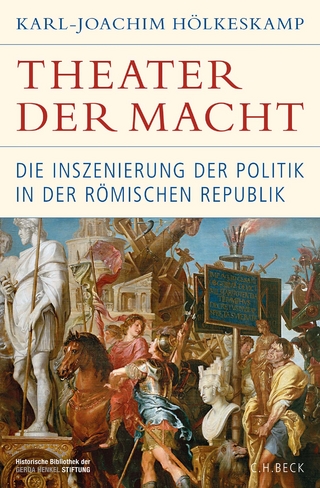Veröffentlichungen aus dem Deutschen Bergbau-Museum Bochum / Das Imperium macht Blau
Zum römischen Azurit-Bergbau in Wallerfangen/Saar
Seiten
2023
VML Vlg Marie Leidorf (Verlag)
978-3-86757-046-6 (ISBN)
VML Vlg Marie Leidorf (Verlag)
978-3-86757-046-6 (ISBN)
Azurit aus Wallerfangen/Saar war ein begehrtes Gut: In römischer Zeit, im Mittelalter sowie in der Neuzeit fand in Wallerfangen Bergbau auf das blaue Kupfermineral Azurit statt. Dieser Azurit aus Wallerfangen wurde in allen Perioden in erster Linie als blaues Pigment genutzt, z.B. in der Wandmalerei. Nach ersten Ausgrabungen vor allem im sog. Oberen Emilianus-Stollen in den 1960er Jahren durch das Konservatoramt des Saarlandes entwickelte sich der römische Bergbau in Wallerfangen zu einem „Hausprojekt“ des Deutschen Bergbau-Museums Bochum. In den 1990er Jahren wurde der sog. Untere Emilianus-Stollen durch Prof. Dr. Gerd Weisgerber untersucht. Zwischen 2003 und 2019 wurde der Stollen Bruss samt zugehörigem Abbauraum durch die Verfasserin, die stellvertretende Leiterin des Forschungsbereichs Montanarchäologie, Dr. Gabriele Körlin, in 13 Kampagnen erforscht. Der Fokus des Projektes lag auf der Erforschung des römischerzeitlichen Bergbaus und seiner Relikte, der angewandten Abbau-Techniken sowie der zu erwartenden Fördermengen des Azurits. Obwohl mit diesen Gruben nur ein Ausschnitt des römischen Reviers in Wallerfangen erfasst wird, liefert dieser zahlreiche Erkenntnisse u.a. zum Vortrieb und Abbau, den verwendeten Gezähen, der Wasserhaltung u.v.m. Ungewöhnlich ist die Wasserhaltung mittels einer völlig überdimensionierten Wasserseige. Hervorzuheben ist die vor Ort angebrachte römische Okkupationsinschrift des Emilianus, ein Alleinstellungsmerkmal für das Wallerfanger Revier. Geophysikalische Prospektionen im direkten Umfeld des Stollens Bruss ergänzen die untertägigien Ausgrabungen. Die vorliegende Publikation zeigt die Ergebnisse der montanarchäologischen Ausgrabungen zum römischen Bergbau, eingebettet in das archäologische Umfeld der Region.
Azurite from Wallerfangen/Saar was a highly sought-after commodity, and this blue copper mineral was mined in Wallerfangen in the Roman period, the Middle Ages and modern times. In all periods, azurite from Wallerfangen was primarily used as a blue pigment, for example in wall paintings. After initial excavations especially in the so-called Upper Emilianus tunnel in the 1960s, carried out by the Saarland heritage management agency [Konservatoramt des Saarlandes], Roman mining in Wallerfangen developed into a focus project at the Deutsches Bergbau-Museum Bochum. In the 1990s, Prof. Dr. Gerd Weisgerber explored the so-called lower Emilianus tunnel. Between 2003 and 2019, the author – Dr. Gabriele Körlin, the deputy head of the research unit on mining archaeology – investigated the Bruss tunnel over the course of 13 campaigns. The project focused on studying Roman mining and its remains, as well as on the mining technologies used and on the expected level of azurite production. Although these mines only represent a fraction of the area exploited by the Romans in Wallerfangen, numerous insights were gained, amongst others into drift and mining, the tools used, water management and so on. Unusually, water management amongst others involved an overdimensional gullet. The Roman occupation inscription of Emilianus deserves to be stressed, as it forms a unique characteristic of the Wallerfang mining area. Geophysical prospection in the immediate surroundings of the Bruss tunnel supplement the excavations below ground. The present publication showcases the results of the excavations focused on Roman mining archaeology, integrated within the archaeological context of the wider region. Azurite from Wallerfangen/Saar was a highly sought-after commodity, and this blue copper mineral was mined in Wallerfangen in the Roman period, the Middle Ages and modern times. In all periods, azurite from Wallerfangen was primarily used as a blue pigment, for example in wall paintings. After initial excavations especially in the so-called Upper Emilianus tunnel in the 1960s, carried out by the Saarland heritage management agency [Konservatoramt des Saarlandes], Roman mining in Wallerfangen developed into a focus project at the Deutsches Bergbau-Museum Bochum. In the 1990s, Prof. Dr. Gerd Weisgerber explored the so-called lower Emilianus tunnel. Between 2003 and 2019, the author – Dr. Gabriele Körlin, the deputy head of the research unit on mining archaeology – investigated the Bruss tunnel over the course of 13 campaigns. The project focused on studying Roman mining and its remains, as well as on the mining technologies used and on the expected level of azurite production. Although these mines only represent a fraction of the area exploited by the Romans in Wallerfangen, numerous insights were gained, amongst others into drift and mining, the tools used, water management and so on. Unusually, water management amongst others involved an overdimensional gullet. The Roman occupation inscription of Emilianus deserves to be stressed, as it forms a unique characteristic of the Wallerfang mining area. Geophysical prospection in the immediate surroundings of the Bruss tunnel supplement the excavations below ground. The present publication showcases the results of the excavations focused on Roman mining archaeology, integrated within the archaeological context of the wider region.
Azurite from Wallerfangen/Saar was a highly sought-after commodity, and this blue copper mineral was mined in Wallerfangen in the Roman period, the Middle Ages and modern times. In all periods, azurite from Wallerfangen was primarily used as a blue pigment, for example in wall paintings. After initial excavations especially in the so-called Upper Emilianus tunnel in the 1960s, carried out by the Saarland heritage management agency [Konservatoramt des Saarlandes], Roman mining in Wallerfangen developed into a focus project at the Deutsches Bergbau-Museum Bochum. In the 1990s, Prof. Dr. Gerd Weisgerber explored the so-called lower Emilianus tunnel. Between 2003 and 2019, the author – Dr. Gabriele Körlin, the deputy head of the research unit on mining archaeology – investigated the Bruss tunnel over the course of 13 campaigns. The project focused on studying Roman mining and its remains, as well as on the mining technologies used and on the expected level of azurite production. Although these mines only represent a fraction of the area exploited by the Romans in Wallerfangen, numerous insights were gained, amongst others into drift and mining, the tools used, water management and so on. Unusually, water management amongst others involved an overdimensional gullet. The Roman occupation inscription of Emilianus deserves to be stressed, as it forms a unique characteristic of the Wallerfang mining area. Geophysical prospection in the immediate surroundings of the Bruss tunnel supplement the excavations below ground. The present publication showcases the results of the excavations focused on Roman mining archaeology, integrated within the archaeological context of the wider region. Azurite from Wallerfangen/Saar was a highly sought-after commodity, and this blue copper mineral was mined in Wallerfangen in the Roman period, the Middle Ages and modern times. In all periods, azurite from Wallerfangen was primarily used as a blue pigment, for example in wall paintings. After initial excavations especially in the so-called Upper Emilianus tunnel in the 1960s, carried out by the Saarland heritage management agency [Konservatoramt des Saarlandes], Roman mining in Wallerfangen developed into a focus project at the Deutsches Bergbau-Museum Bochum. In the 1990s, Prof. Dr. Gerd Weisgerber explored the so-called lower Emilianus tunnel. Between 2003 and 2019, the author – Dr. Gabriele Körlin, the deputy head of the research unit on mining archaeology – investigated the Bruss tunnel over the course of 13 campaigns. The project focused on studying Roman mining and its remains, as well as on the mining technologies used and on the expected level of azurite production. Although these mines only represent a fraction of the area exploited by the Romans in Wallerfangen, numerous insights were gained, amongst others into drift and mining, the tools used, water management and so on. Unusually, water management amongst others involved an overdimensional gullet. The Roman occupation inscription of Emilianus deserves to be stressed, as it forms a unique characteristic of the Wallerfang mining area. Geophysical prospection in the immediate surroundings of the Bruss tunnel supplement the excavations below ground. The present publication showcases the results of the excavations focused on Roman mining archaeology, integrated within the archaeological context of the wider region.
| Erscheinungsdatum | 29.11.2023 |
|---|---|
| Reihe/Serie | Der ANSCHNITT ; 52 | Veröffentlichungen aus dem Deutschen Bergbau-Museum Bochum ; 259 |
| Co-Autor | Monika Doll, Michael Ecker, Marco Haardt, Constanze Höpken, David Jaensch, Carmen Keßler, Thomas Kirnbauer, Barbara Matthes, Beate Sikorski, Gero Steffens |
| Verlagsort | Rahden |
| Sprache | deutsch |
| Maße | 210 x 298 mm |
| Gewicht | 1220 g |
| Einbandart | gebunden |
| Themenwelt | Geschichte ► Allgemeine Geschichte ► Altertum / Antike |
| Schlagworte | Azuritbergbau • Deutschland • Pigmente • Römische Kaiserzeit • Saarland • Wallerfangen |
| ISBN-10 | 3-86757-046-9 / 3867570469 |
| ISBN-13 | 978-3-86757-046-6 / 9783867570466 |
| Zustand | Neuware |
| Haben Sie eine Frage zum Produkt? |
Mehr entdecken
aus dem Bereich
aus dem Bereich
Die unglaubliche Geschichte eines antiken Söldnerheeres
Buch | Hardcover (2022)
C.H.Beck (Verlag)
CHF 39,20
die Inszenierung der Politik in der römischen Republik
Buch | Hardcover (2023)
C.H.Beck (Verlag)
CHF 67,20




